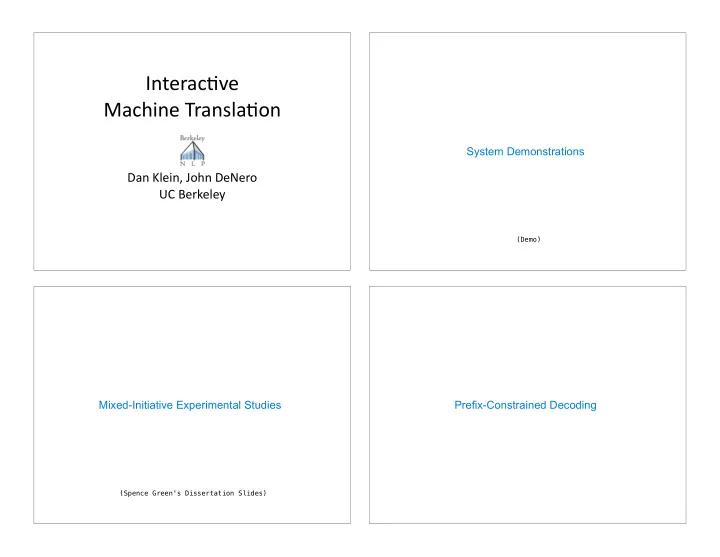

Interac(ve Machine Transla(on System Demonstrations Dan Klein, John DeNero UC Berkeley (Demo) Mixed-Initiative Experimental Studies Prefix-Constrained Decoding (Spence Green's Dissertation Slides)
Prefix Decoding Phrase-Based Prefix-Constrained Decoding A user enters a prefix of the translation; the MT system predicts Early work [Barrachina et al. 2008; Ortiz-Martínez et al. 2009]: the rest. Standard phrase-based beam search, but discard hypotheses that don't match the prefix. Yemeni media report that there is traffic chaos in the capital. Once the user has typed: Jemenitische Medien berichten von einem Verkehrschaos The system suggests: Better version [Wuebker et al. 2016]: While aligning the prefix in der Hauptstadt. to the source, use one beam per target cardinality. While generating the suffix of the translation, use one beam per source cardinality. Suggestion is useful when: Also added: •Sentence is completed in a way that a translator accepts, •Different translation model weights for phrases in the prefix •The next word suggestion is acceptable, and suffix (lexical features are more relevant for alignment). •Sentence is completed in a way that requires minimal post-editing. •Phrases extracted from the source and prefix to ensure coverage. Neural Prefix-Constrained Decoding Prefix Decoding: Phrase-Based vs Neural State-of-the-art neural MT model from 2015 [Luong et al., 2015]: autodesk newstest2015 •4-layer stacked LSTM with attention. •Embedding size & hidden unit size of 1000. En-De BLEU Next BLEU Next •50-sentence mini-batches of sentences with length 50 or less; trained with SGD. word word accuracy accuracy •Before layer normalization, residual connections, back translation, knowledge distillation, Transformer architecture, subwords, or label smoothing. Phrasal 44.5 37.8 22.4 28.5 baseline •Beam size of 12 for the suffix; beam size of 1 for the prefix (the constrained word). Phrasal 44.5 46.0 22.4 41.2 improved NMT 40.6 52.3 23.2 50.4 NMT ensemble 44.3 54.9 26.3 53.0 Wuebker et al., 2016, "Models and Inference for Prefix-Constrained Machine Translation"
Online Fine-Tuning for Model Personalization After sentence i is translated, take a stochastic gradient descent step with batch size 1 on (x i , y i ) [Turchi et al., 2017]. Evaluation via simulated post-editing [Hardt and Elming, 2010]: •Adaptation is performed incrementally on the test set. •Translate x i using model θ i-1 and compare it to reference y i . •Then, estimate θ i from (x i , y i ). Online Adaptation E.g., Autodesk corpus results using a small Transformer: •Unadapted baseline: 40.3% BLEU •Online adaptation: 47.0% BLEU Recall of observed words goes up, but unobserved words goes down [Simianer et al., 2019]: •R1 — % of words appearing for the second time in any reference that also appear in the corresponding hypothesis: 44.9% -> 55.0% •R0 — % of words appearing for the first time in any reference that also appear in the corresponding hypothesis: 39.3% -> 35.8% Turchi et al., 2017, "Continuous learning from human post-edits for neural machine translation." Simianer et al., 2019, "Measuring Immediate Adaptation Performance for Neural Machine Translation" dec. embeddings inner layers outer layers A sheathed-element glow plug ... Encoder enc. embeddings output proj. Decoder Space-Efficient Model Adaptation Output projection 10.3M (5.5M) Filter Filter Encoder attention Inference for "personalized" (user-adapted) models: Self-attention Self-attention ... Filter •Load User X’s model from cache or persistent storage Filter 4 × Encoder attention •Apply model parameters to computation graph Self-attention Self-attention ... •Perform inference Filter Filter 788K Encoder attention 526K Self-attention Self-attention Example production constraint: latency budget of 300ms ⇒ maximum of ~10M parameters for a personalized model Embedding lookup 10.3M Embedding lookup 10.3M (5.0M) (5.5M) Eine Glühstiftkerze (1) dient ... <s> A sheathed-element glow plug … # parameters Full (small transformer) model in 2019: ~36M parameters batch adaptation online adaptation # params Solution: baseline 33.7 36.2M •Store models as offsets from baseline model: W = W b + W u full model 41.7 39.0 25.8M outer layers 38.6 37.9 2.2M •Select sparse parameter subset W u inner layers 38.8 37.8 2.7M enc. embeddings 36.3 35.7 5.0M dec. embeddings 34.2 34.3 5.5M output proj. 38.7 37.5 5.5M
Group Lasso Regularization for Sparse Adaptation Bottleneck Adapter Modules Simultaneous regularization and tensor selection Adapter modules: •Add offsets to activations Regularize offsets Wu, define each tensor as one group g for L1/ by a combination of new L2 regularization adapter layers and residual connections. •Initialize adapter layer Total loss: weights near zero. •During adaptation, freeze all model parameters Cut off all tensors g with: except the adapter layers. Define a group for each hidden layer and each embedding column BERT GLUE en>fr fr>en en>ru ru>en en>zh zh>en Baseline 28.8 35.8 10.7 29.7 19.9 18.9 Full Adaptation 36.6 49.6 21.0 42.1 40.6 46.6 Sparse Adapt. 36.2 49.2 21.2 42.2 42.0 46.5 (# params) (16.5%) (15.9%) (16.1%) (15.8%) (15.6%) (15.2%) Houlsby et al., 2019, "Parameter-Efficient Transfer Learning for NLP" Wuebker et al., 2018, "Compact Personalized Models for Neural Machine Translation" Bapna & Firat, 2019. "Simple, Scalable Adaptation for Neural Machine Translation" Word Alignment Applications Simple terminology-constrained inference: •Users often specify termbases, which act as restrictions on the target translation. •When attention focuses on a source term, add the corresponding target term to the translation hypothesis. Tag projection: Tag Projection •Strip markup tags before translation •Project tags to final target sentence using word alignments From Wikipedia : <span><b>Translation</b> is the communication of the <a1>meaning</a1> of a <a2>source-language</a2> text by means of an <a3>equivalent</a3> <a4>target-language</a4> text.<sup><a5>[1]</a5></sup></span> Google Translate : <span><b>Übersetzung</b> ist die Übermittlung der <a1>Bedeutung</a1> eines <a2>quellsprachlichen</a2> Textes mittels eines <a3>äquivalenten</a3> <a4>zielsprachlichen</a4> Textes.<sup><a5>[1]</a5></sup></span>
Recommend
More recommend